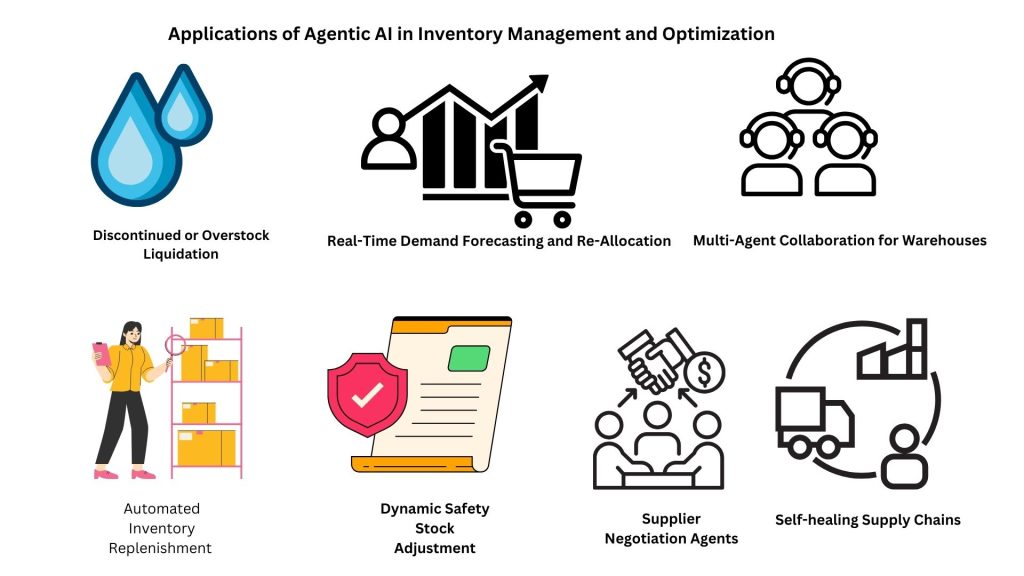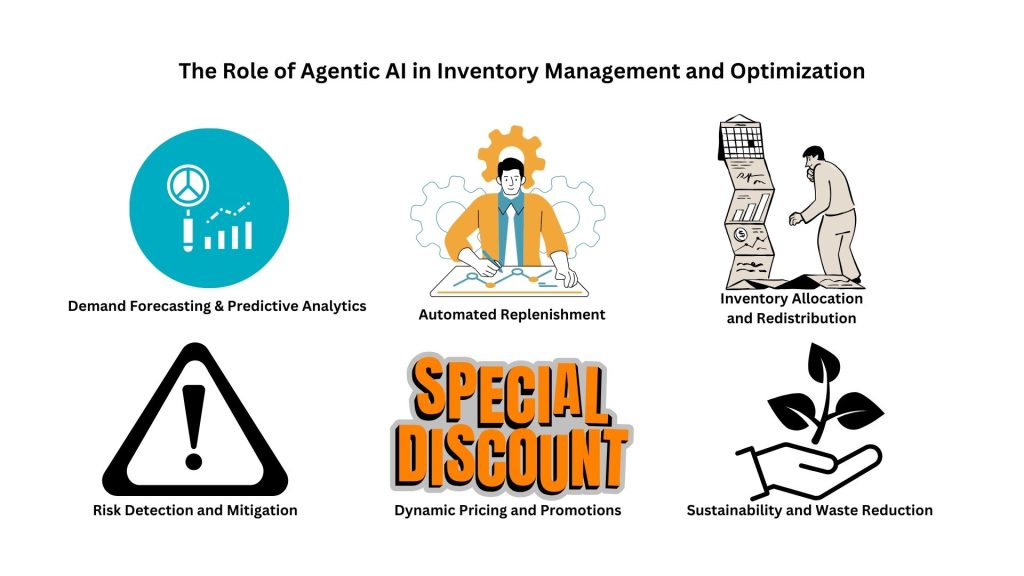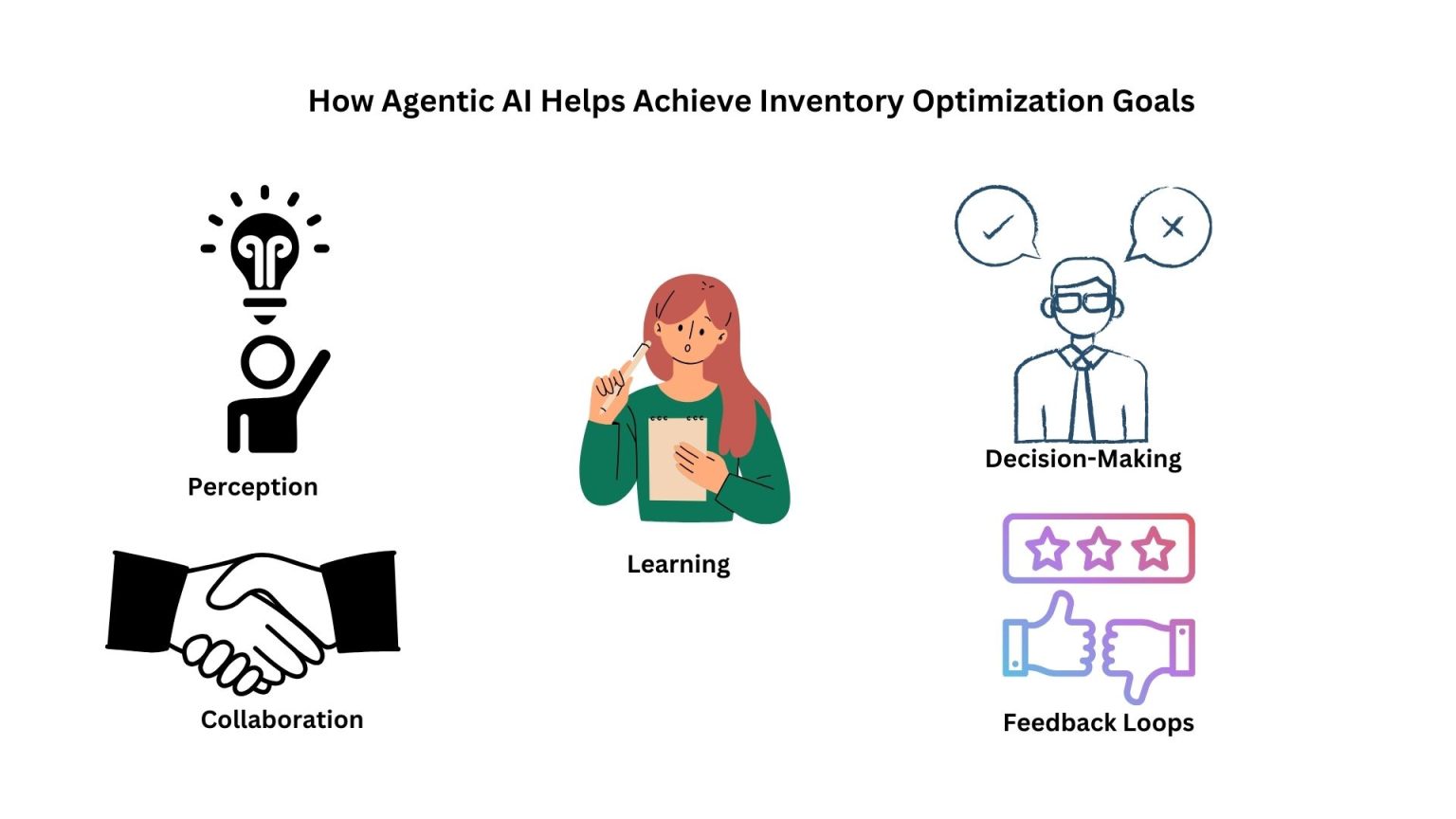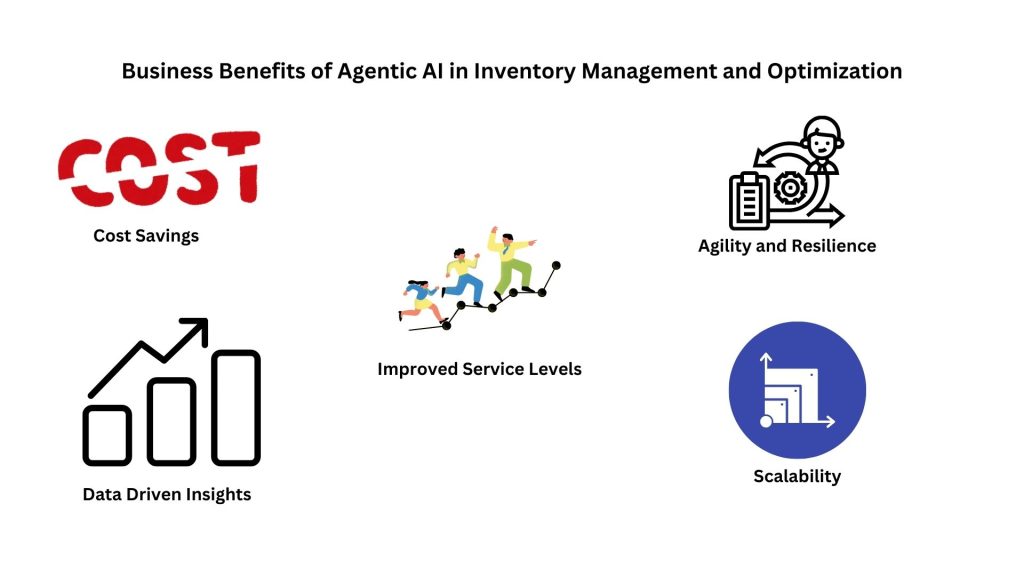
The advent of Agentic AI (Artificial Intelligence) is reshaping inventory management and optimization. By shifting from rule-based systems to intelligent, self-adaptive agents, businesses can achieve unprecedented levels of efficiency, responsiveness, and profitability. As the technology continues to evolve, the integration of Agentic AI into inventory management and optimization will be a cornerstone of digital transformation strategies across industries.
Agentic AI in inventory optimization is a cutting-edge approach where AI agents operate autonomously to make decisions, plan actions, and continuously optimize inventory systems without requiring constant human intervention.
These agents are goal-driven and can self-adapt based on dynamic environments, making them highly effective for inventory management in industries like retail, manufacturing, and logistics. Embracing Agentic AI improves operational efficiency, and positions businesses to thrive in an increasingly competitive marketplace. The future of inventory management and optimization is intelligent and autonomous, driven by the power of Agentic AI.
Applications of Agentic AI in Inventory Management and Optimization

Key applications of Agentic AI in inventory management and optimization include:
- Automated Inventory Replenishment
Agentic AI can autonomously decide:
- When to reorder stock
- How much to reorder
- Which suppliers to select
- Prioritize faster delivery vs. lower cost.
Example: A retail store AI agent monitors stock levels in real-time and automatically places purchase orders with multiple suppliers based on price, demand forecasts, and delivery speed — without any human input.
Dynamic Safety Stock Adjustment
Instead of using fixed safety stock levels, agents dynamically adjust safety stock based on:
- Demand volatility
- Supply chain disruptions
- Seasonal patterns
- Competitor activity
Example: A pharmaceutical distributor uses agentic AI to increase safety stock for flu medication during sudden outbreaks, based on social media trends and weather forecasts.
Multi-Agent Collaboration for Warehouses
Multiple autonomous agents working together can optimize warehouse operations, as follows:- One agent predicts demand
- Another agent plans inventory allocation across warehouses
- A third agent minimizes storage costs by suggesting stock transfers between warehouses.
Example: Amazon-like fulfilment centers where multiple AI agents coordinate between warehouses to automatically balance inventory across locations.
Supplier Negotiation Agents
AI agents can autonomously negotiate with suppliers to optimize:- Cost
- Delivery time
- Minimum order quantities
Example: An electronics retailer uses AI agents to automatically request quotes from suppliers, negotiate discounts, and select the best deal.
Discontinued or Overstock Liquidation
AI agents can automatically identify slow-moving or obsolete inventory and initiate:- Discount pricing strategies
- Cross-channel liquidation (eBay, Amazon, or other marketplaces)
- Dynamic bundle offers
Example: Zara uses AI agents to automatically price down unsold seasonal products before the next collection arrives.
Real-Time Demand Forecasting and Re-Allocation
Instead of static forecasts, agentic AI continuously updates demand predictions and reallocates inventory across stores or regions.Example: A grocery chain automatically shifts high-demand products (such as bottled water during heatwaves) between nearby stores based on live demand data.
Self-Healing Supply Chains
AI agents proactively detect disruptions, such as shipping delays or factory shutdowns and automatically:- Source alternative suppliers
- Divert inventory from other regions
- Adjust delivery schedules.
Example: Apple uses AI agents to reroute components supply from backup suppliers during chip shortages.
Agentic AI is a Game-Changer for Inventory Management and Optimization
Below are a few foundational differences between traditional AI and Agentic AI:
Traditional AI
Agentic AI
Rule-based Automation
Self-Learning & Goal-Oriented Agents
Fixed Parameters
Adaptive Strategies
Requires Human Approval
Fully Autonomous Decisions
Batch Processing
Real-Time Continuous Optimization
Various tools & technologies powering Agentic AI for intelligent inventory management and optimization include:
- Large Language Models (LLMs), such as ChatGPT
- Reinforcement Learning (RL) Agents
- Digital Twins
- Multi-Agent Frameworks (e.g., AutoGPT and LangChain)
- Decision-making engines (e.g., OpenAI Function Calling and Microsoft Copilot Studio).
Intelligent Inventory Management and Optimization: Realizing the Vision with Agentic AI
In today’s fast-paced business environment, inventory management and optimization plays a critical role in ensuring operational efficiency, meeting customer demands, and maximizing profitability. Traditional inventory management methods, often relying on static rules and manual oversight, struggle to keep up with the complexities of modern supply chains. The rise of Artificial Intelligence (AI) and, more specifically, Agentic AI, is transforming inventory management and optimization into a more intelligent, automated, and optimized process. But what exactly is Intelligent Inventory Management and Optimization, and how is Agentic AI helping businesses achieve these goals?
Unravelling Intelligent Inventory Management and Optimization
Intelligent Inventory Management and optimization refers to the application of advanced technologies, such as Agentic AI and data analytics to monitor, control, and optimize inventory levels. Unlike traditional inventory systems that follow pre-defined rules or static thresholds, intelligent systems powered by Agentic AI leverage real-time data, predictive algorithms, and autonomous decision-making to dynamically manage inventory across the entire supply chain.
Optimization, in this context, goes beyond merely maintaining minimum stock levels or preventing stockouts. It involves a holistic approach where businesses aim to:
- Minimize holding costs
- Improve order fulfilment rates
- Balance supply and demand fluctuations
- Enhance operational efficiency
- Reduce wastage and obsolescence
- Maximize customer satisfaction.
The ultimate goal of Intelligent Inventory Management and Optimization is to create a self-adaptive system that responds to market changes, customer demands, and supply chain disruptions without much human intervention.
The Role of Agentic AI in Inventory Management and Optimization

Agentic AI represents a new paradigm in AI where autonomous agents can perceive their environment, making decisions, and executing actions to achieve predefined goals. These AI agents act as intelligent decision-makers, continuously learning from data, collaborating with other agents, and adapting to dynamic environments. In the context of inventory management, Agentic AI can revolutionize how businesses handle stock, logistics, and procurement. Here’s how:
1. Demand Forecasting and Predictive Analytics
Agentic AI leverages historical sales data, market trends, and external factors (such as weather patterns, economic indicators, or competitor pricing) to predict future demand accurately. These agents autonomously adjust forecasting models based on real-time data, improving accuracy over time and helping businesses anticipate stock requirements.
2. Automated Replenishment
Instead of relying on fixed reorder points, Agentic AI agents dynamically calculate optimal replenishment quantities and trigger purchase orders based on predicted demand, lead times, and supplier performance. These autonomous agents can even negotiate with suppliers, compare pricing, and select the best vendors without human intervention.
3. Inventory Allocation and Redistribution
For businesses with multiple warehouses or retail locations, Agentic AI can optimize inventory distribution by reallocating stock between locations based on local demand patterns. This minimizes stockouts in high-demand areas while avoiding overstocking in low-demand regions.
4. Risk Detection and Mitigation
Agentic AI continuously monitors supply chain data to detect potential risks such as delayed shipments, quality issues, or demand surges. When risks are identified, the agents autonomously trigger mitigation actions—like reordering from alternative suppliers or rerouting shipments—to minimize disruptions.
5. Dynamic Pricing and Promotions
By analyzing customer behavior, competitor pricing, and inventory levels, Agentic AI can recommend dynamic pricing strategies and promotional offers. This not only helps in clearing excess inventory but also maximizes revenue during periods of fluctuating demand.
6. Sustainability and Waste Reduction
Agentic AI helps businesses optimize inventory to minimize wastage by aligning procurement with actual demand patterns. Perishable goods, for example, can be prioritized for faster delivery, while surplus stock can be automatically diverted to alternative channels or discount sales.
How Agentic AI Helps Achieve Inventory Optimization Goals

The power of Agentic AI lies in its ability to create self-governing systems that improve over time. Here’s how these autonomous agents work together to achieve inventory optimization goals:
- Perception: Agents continuously ingest data from Internet of Things (IoT) sensors, enterprise resource planning (ERP) systems, customer orders, and external data sources.
- Learning: Machine learning (ML) algorithms allow agents to identify patterns, correlations, and anomalies in data.
- Decision-Making: Based on learned insights, agents autonomously generate recommendations or trigger actions.
- Collaboration: Multiple agents representing different aspects of inventory (demand forecasting, procurement, logistics) communicate and coordinate actions.
- Feedback Loops: The system continuously refines its models through feedback loops, improving performance and decision accuracy.
Business Benefits of Agentic AI in Inventory Management and Optimization

By implementing Agentic AI, businesses can realize several tangible benefits, including:
- Cost Savings: Automated decision-making reduces labor costs and minimizes excess inventory holding.
- Improved Service Levels: Better demand forecasts and stock allocation enhance order fulfilment rates.
- Agility and Resilience: Autonomous agents adapt quickly to disruptions, ensuring business continuity.
- Data-Driven Insights: Real-time data analysis empowers businesses with actionable insights for strategic decision-making.
- Scalability: Agentic AI systems can easily scale to manage complex, multi-location supply chains.